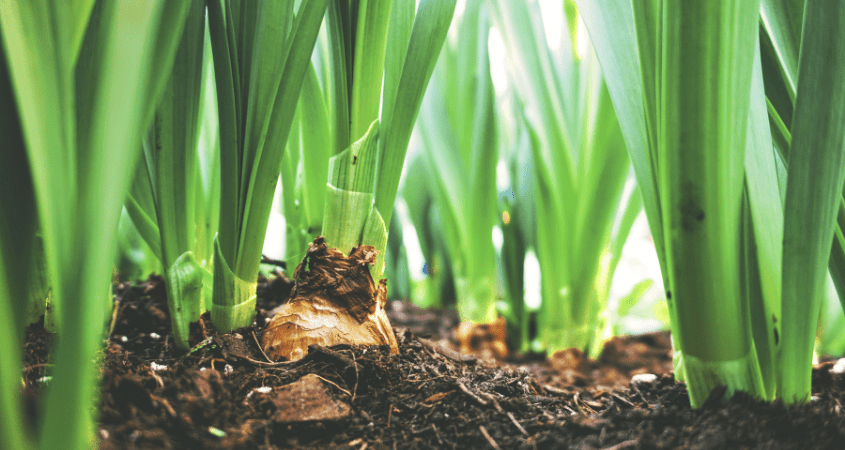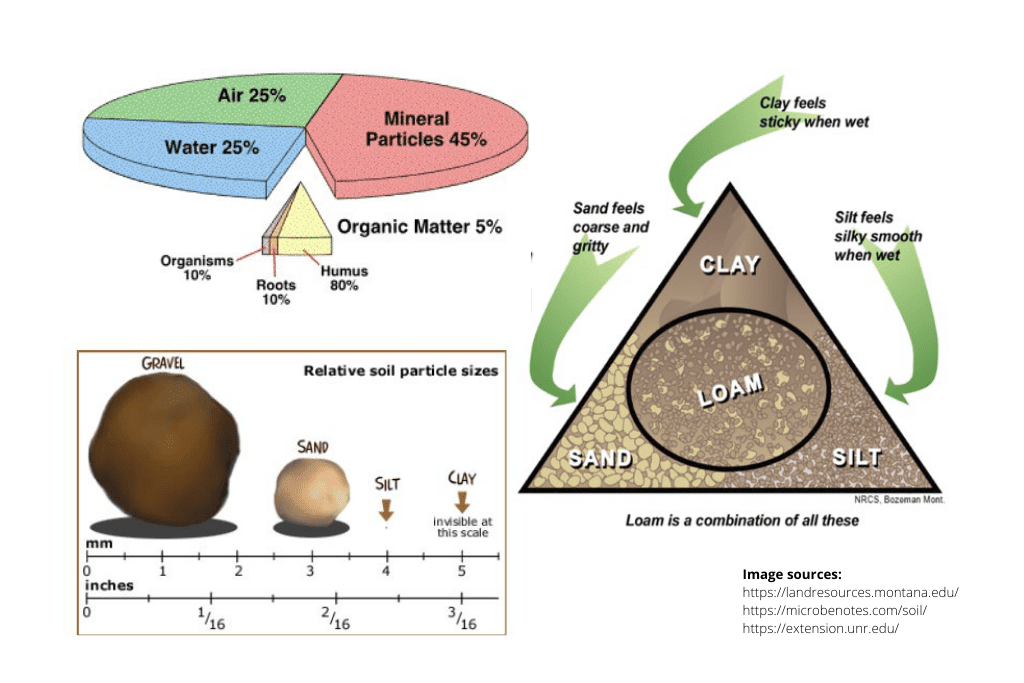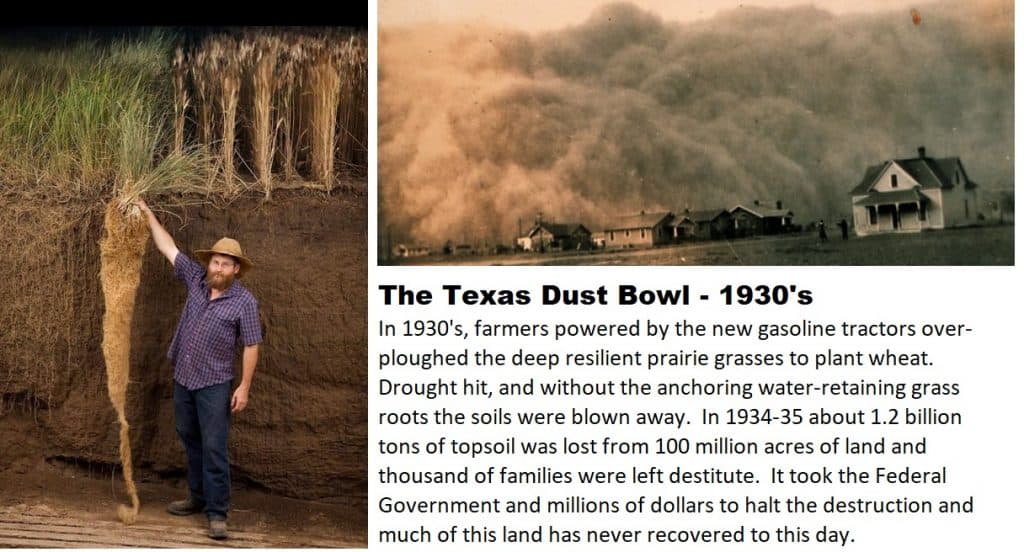
Soil is important not just for growing plants and supporting our farmers, but it plays a major function in the health of the planet. Soil provides us with what are known as ecosystem services, essential for global health. The resilience of the soil is its capacity to recover and bounce back after a change of regime e.g. floods, droughts, ploughing, or pesticide application. At Cropnuts we have a team of Climate-Smart, Agronomic Advisory Specialists to help you monitor and build the resilience of your soils……It all starts and ends with the soil!
Soil is composed of mineral particles, organic matter, air, and water. It is created by weathering of parent rock, and the interaction with roots and living organisms. You get poor soil and good soil. It takes between 200 and 400 years to make 1 cm of soil, and about 3000 years to create a decent soil that will support plants.
An ideal soil contains 45% mineral particles, 25% water, 25% air, and at least 5% organic matter. The makeup of the mineral faction is determined by the parent rock from where it is formed, and the processes involved to create the soil. The particle sizes are classed as gravel (>2mm and mainly considered inert), sand, silt, and clay. Clay is microscopic, is sticky when wet, holds a lot of water but does not drain easily, while sand is coarse and gritty, drains quickly but does not hold much water. The % of sand, silt, and clay in the soil make up the soil texture. A good soil is loam soil that contains an ideal combination of sand, silt, and clay, which allows option drainage, water storage, and aeration. We cannot control our soil texture.

The soil organic matter faction is made up of about 10% plant roots, 10% living organisms, and 80% humus. It is the most important faction, and it is also the faction that we have control over. Underneath the soil is a living ecosystem, known as the soil food web. This faction cannot photosynthesise and is fed by the plants above the soil, who can. “Feeding all the soil organisms below ground in one acre is like feeding two African elephants”, Jerry Hatfield, USDA-ARS.
The soil food web is fuelled by root exudes and plant and animal wastes. The plant roots, organic matter, and soil organisms build the soil structure and resilience. They form soil aggregates that contain macro and micropores, which strengthen the soil and resist wind and water erosion. Soil organic matter reduces soil capping and the macropores allow a greater degree of water infiltration and water storage during the rains, and the micropores hold strongly onto the last drops of water in droughts, keeping pockets of soil organisms alive to bloom again.
The organic matter contains about 58% organic carbon, which may be classified as active carbon or inactive carbon. Higher active carbon levels indicate a healthier more active soil. The humus content of the soil greatly increases the water and nutrient holding capacity of sandy soils, and the drainage and nutrient availability of clay soils. When soil humus levels are higher it takes fewer nutrients to produce crops, (a point to note with the high fertiliser prices!). Each 1% increase in soil organic matter can hold an extra 190,000 litres of water per hectare. Water is the biggest limiting factor to plant growth in Africa.

The Ecosystem Services provided to us by the soil are extremely important for our health and the health of the plant. Soils grow food. They store, percolate and purify water. They store and re-cycle nutrients, keeping our plants healthy and water courses clean, soils act as a Carbon and Nitrogen sink, keeping the air clean and counteracting climate change. Soils provide habitats, and support structures (e.g. roads and buildings). Microbially active soils re-cycle waste, de-toxify pollutants, and suppress both plant and human pathogens. Without healthy active soils, we would not have clean air and water and would soon be buried under our own wastes.
Healthy soil is a finite resource. It takes 3000 years to build decent soil, however, 25,000 tons of good topsoil get washed away every year. 2000 million hectares of productive soils are degraded annually, and 5-7 million hectares are lost completely. Soil erosion puts the livelihoods of 1000 million people at risk every year. From the beginning of the 1900s, we have seen a huge rise in the human population, with a predicted 30% increase to 10 billion in 2050. Soil Carbon loss is one of the principal signs of soil degradation, and in this same time, we have seen the loss of 2/3rds of our terrestrial soil Carbon. Africa has 65% of the world’s remaining uncultivated arable land, are we the next Global breadbasket?

Reversing soil degradation and increasing soil organic Carbon of Agricultural land is the surest and lowest cost multiple-win situation for saving our planet. An increase in just 1% carbon in the top 1m of terrestrial soils could potentially reverse climate change. Global rangelands contain cover 54% of the world’s surface, contain 1/3rd of the terrestrial Carbon, and have the highest potential to sequester more.
Moisture is required for plants to grow and produce biomass. Good water management and protection of our water resources is key.
Apply only the soil amendments and fertilisers required for that soil and that crop. Over application of inorganic Nitrogen burns off soil organic carbon. Incorrect fertiliser application can acidify and degrade soils.
While herbivores are required for developing soil Carbon and healthy soils, over-grazing accounts for huge tracts of land being lost due to soil degradation. Proper grazing management will maximise biomass production and water infiltration.
Re-forestation and agroforestry are important. Trees cool the soil, are more permanent, and have deep roots that hold the soil together and move nutrients and moisture up from deeper soil horizons. They have a high Carbon:Nitrogen ratio and large biomass. A great deal of topsoil is lost through unnecessary erosion.




Every time we plough the soil, we are breaking up the soil aggregates, killing the microbes, and burning off the soil’s organic carbon. Every time we drive over the soil, we are compacting it, reducing volume, aeration, and water infiltration.
Precision agriculture, minimum tillage, climate-smart agriculture, regenerative farming, cover cropping, and plant diversification.
Biotechnology to develop higher-yielding more drought-tolerant varieties and develop bio-fertilisers that can help re-populate degraded soils. Mycorrhizae fungi for example have been lost from most of our soils but are important for healthy plant growth and soil carbon capture.
A change in soil regime, for example, cutting down a forest or removal of the riparian vegetation can have far-reaching consequences on the whole landscape.
Science, education, and knowledge sharing are becoming more and more important to reduce the degradation and to rebuilding our soils.
To our detriment, we have become a through away society. We can reduce our Carbon footprint and improve soils by reducing our consumer habits and re-cycling our useful waste and returning as much organic matter as we can back to the soil.
We can learn a great deal from history and national disasters that have happened in other parts of the world due to land degradation and climatic conditions! It is much, much cheaper to strategically plan and reverse soil degradation that to try and re-build soils after an event.
Soils are degrading at an alarming rate, and climate change is accelerating. If all of us did our part to create awareness on the power and importance of our soils to our very existence and we all did as much as we could to improve our soils, we could halt and reverse the effects of soil degradation.
At Cropnuts we can help you analyse and monitor your soils and water, organic matter and organic, active, inorganic, and total soil carbon. We can help you build a robust soil health plan to increase your carbon levels and maximise yields and fertiliser efficiency.
Talk to us today on support@cropnuts.com for any further enquiries
Kindest regards,
Ruth Vaughan
Technical Advisory Services
Cropnuts
Ruth Vaughan is the Technical Advisory Services Manager at Crop Nutrition Laboratory Services Ltd. (CROPNUTS). Ruth is also a contributing author to Kenya’s leading horticulture magazines. Ruth is a great believer in soil health, organic matter, biochar and carbon sequestration as a way to alleviate climate change and increase food security. She loves visiting farmers and seeing all the different farming methods |
Order our services and get to know how to improve your soil for better yeilds.